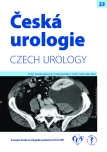Wunderlich’s syndrome – cohort of patients with spontaneous nontraumatic retroperitoneal hemorrhage
Authors:
Vít Paldus 1; Vladimír Šámal 1,2; Jan Mečl 1
Authors‘ workplace:
Urologické oddělení Krajské nemocnice Liberec, a. s., Liberec
1; Urologická klinika FN a LF UK, Hradec Králové
2
Published in:
Ces Urol 2019; 23(3): 230-236
Category:
Original Articles
Overview
Objective: Retrospective evaluation of a cohort of patients who suffered from Wunderlich´s syndrome. Assessment of the etiology, clinical manifestation, standard diagnostic tools and treatment options in patients with Wunderlich´s syndrome.
Methods: We performed a retrospective evaluation of a cohort of 8 patients who suffered from spontaneous renal hemorrhage / retroperitoneal bleeding during the 15 years period. The group of patients was divided according to the etiology, clinical manifestation, diagnostic tools and treatment procedures performed in individual patients. Post treatment clinical evaluation was performed as well.
Results: There were 4 cases of renal hemorrhage / retroperitoneal bleeding due to spontaneous rupture of angiolipoma. 2 patients suffered from bleeding due to renal carcinoma rupture. There was 1 patient with tuberous sclerosis and 1 patient with spontaneous rupture of the extra adrenal pheochromocytoma (an extremely rare condition). 5 patients underwent open surgical treatment, while in the remaining 3 patients endovascular procedure was performed (with the aim of preserving the affected organ/kidney). There were no serious adverse events related to the procedure performed / with relationship to the performed procedure. One patient died shortly after the procedure due to tumor progression. The remaining patients are alive.
Conclusion: Spontaneous, nontraumatic renal hemorrhage / retroperitoneal bleeding presented as Wunderlich´s syndrome is a very serious and in some cases life threatening condition. Therapeutic approach is determined by the assessment of the patient´s health status as well as by the possible etiology of bleeding.
Keywords:
angiomyolipoma – Wunderlich´s syndrome – renal carcinoma – extra-adrenal pheochromocytoma – renal lymphangioleiomyomatosis / lymphangioleiomyomatosis of kidney
Sources
1. Michal M, Hes O, Mukenšnabl P. Nádory ledvin dospělého věku. Euroverlag 2000 : 10–12, 54–79, 98–112.
2. Hora M, Hes O, Klecka J, et al. Rupture of papillary renal cell carcinoma. Scand J Urol Nephrol 2004; 38(6): 481–484.
3. Procházková K, Staehler M, Trávníček I, et al. Morphological Characterization of Papillary Renal Cell Carcinoma Type 1, the Efficiency of Its Surgical Treatment. Urol Int. 2017; 98(2): 148–155.
4. Eble JN. Angiomyolipoma of Kidney. Seminars in Diag. Pathol. 1998; 15(1): 21–40.
5. Vrtěl R, Vodička R, Šantavá A, Šantavý J, Krejčiříková E. Angiomyolipomy a jejich vyšetření v diagnostice tuberózní sklerózy. Čas. Lék. Čes. 2004; 143 : 195–197.
6. Wiliams RD, Dreicer R. Renal Parenchymal Neoplasms. Tanagho EA, McAninch WJ. Smiths General Urology, XIX. ed., Prentice‑Hall Intern. Inc, 1995; 372–374.
7. Wong K, Waters CM, Hershman MJ, Kaisary VA, Horner J. Angiomyolipoma of the kidney: a clinical enigma in diagnosis and management. Annals of the Royal College of Surg. Of Engl. 1992; 74 : 144–148.
8. Fleischmann J, Huntley HN. Renal Tumors. Clinical Urology. J. B. Lippincot Comp., 1994; 369–37
9. Klézl P, Richterová R, Štanc O, Klečka J, Záťura F. Objemný angiomyolipom pravé ledviny u mladé ženy. Urol List 2013; 11(4): 45–48.
10. Gyimadu AO, Kara O, Basaran D, Esinler I. Conservative management of a retroperitoneal hemorrhage following a ruptured renal angiomyolipoma in pregnancy. J Obstet Gynaecol Res 2011; 37(2): 156–159.
11. Chang SY, Ma CP, Lee SK. Spontaneous retroperitoneal hemorrhage from kidney causes. Eur Urol 1988; 15(3–4): 281–284.
12. Kendall AR, Senay BA, Coll ME. Spontaneous subcapsular renal hematoma: diagnosis and management. Urology 1988; 139(2): 246–250.
13. Moratalla MB. Wunderlich’s syndrome due to spontaneous rupture of large bilateral angiomyolipomas. Emerg Med J 2009; 26(1): 72.
14. Hellstrom PA, Mehik A, Talja MT, et al. Spontaneous subcapsular or perirenal haemorrhage caused by renal tumours. A urological emergency. Scand J Urol Nephrol 1999; 33(1): 17–23.
15. Adanur S, Ziypak T, Koç E et al. Renal angiomyolipoma causing retroperitoneal hemorrhage (Wunderlich syndrome): Presentation of our clinical experiences. European Urology Supplements 2013; 12 (4): e1365.
16. Arabagiu I, Multescu DR, Cozma C, et al. Particular aspect in the diagnosis and treatment of Wunderlich syndrome. European Urology Supplements 2019; 18 (2): e2350.
17. Ürge T, Hora M, Hes O, Chudáček Z. Renální angiomyolipom, histologie, diagnostika a terapie. Urolog. praxi 2005; 270–272.
18. Spahn D, Bouillon B, Cerny V, et al. The European guideline on management of major bleeding and coagulopathy following trauma: fifth edition. Critical Care 2019; 23 : 98.
Labels
Paediatric urologist Nephrology UrologyArticle was published in
Czech Urology

2019 Issue 3
Most read in this issue
- PSA and its isoforms as modern markers of prostate cancer
- Urological complications after kidney transplantation
- Wunderlich’s syndrome – cohort of patients with spontaneous nontraumatic retroperitoneal hemorrhage
- Urothelial carcinoma of right renal pelvis and left distal urether
